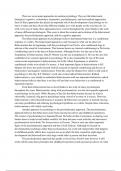Summary
Summary Essay on the 7 Approaches to Psychology
- Course
- Psychology
- Institution
- 12th Grade
Essay summarizing the 7 main approaches to psychology which are behavioural, biological, cognitive, evolutionary, humanistic, psychodynamic, and sociocultural
[Show more]



